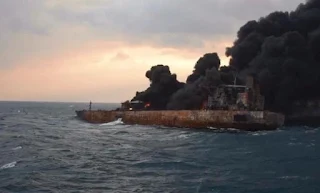Chinese authorities are struggling to contain what may be the worst oil tanker spill and environmental disaster of its kind in history, after the stricken Iranian ship. The Sanchi, finally sank over the weekend.
The Sanchi was carrying 136,000 tonnes, or roughly 1 million barrels, of condensate, an ultra-light, highly flammable form of crude oil, when it crashed into the CF Crystal, a Hong Kong-registered freighter, in Japan’s exclusive economic zone (EEZ) following strong winds on January 6. A prolonged fire followed making rescue efforts near impossible.
The tanker finally sank later on Sunday after a new, more intense fire erupted, sending plumes of thick black smoke 1km (3,280ft) into the skies above the East China Sea. The search and rescue operation was cancelled Monday and the crew of 30 Iranians and two Bangladeshis are presumed dead following the incident.
The clean-up operation to contain the spill, which extends over an area of roughly 50 square miles (129 sq km), has been hampered by the intense fires and repeated explosions, which are believed to have ruptured the ship’s hull in multiple areas.
“Given the poor condition of the hull of the ship after a week of explosions and fire, it is my assumption that none of the cargo holds or fuel compartments remain intact, and thus all of the condensate and fuel has been released,” oil spill consultant Richard Steiner told AFP, adding that he believed the accident may be "the single largest environmental release of petroleum condensate in history."
"I don't know of any condensate spill into a marine environment larger than 1,000 tonnes, and most that we know of have been less than one tonne," he added.
(RT)
15/1/18
The Sanchi was carrying 136,000 tonnes, or roughly 1 million barrels, of condensate, an ultra-light, highly flammable form of crude oil, when it crashed into the CF Crystal, a Hong Kong-registered freighter, in Japan’s exclusive economic zone (EEZ) following strong winds on January 6. A prolonged fire followed making rescue efforts near impossible.
The tanker finally sank later on Sunday after a new, more intense fire erupted, sending plumes of thick black smoke 1km (3,280ft) into the skies above the East China Sea. The search and rescue operation was cancelled Monday and the crew of 30 Iranians and two Bangladeshis are presumed dead following the incident.
The clean-up operation to contain the spill, which extends over an area of roughly 50 square miles (129 sq km), has been hampered by the intense fires and repeated explosions, which are believed to have ruptured the ship’s hull in multiple areas.
“Given the poor condition of the hull of the ship after a week of explosions and fire, it is my assumption that none of the cargo holds or fuel compartments remain intact, and thus all of the condensate and fuel has been released,” oil spill consultant Richard Steiner told AFP, adding that he believed the accident may be "the single largest environmental release of petroleum condensate in history."
"I don't know of any condensate spill into a marine environment larger than 1,000 tonnes, and most that we know of have been less than one tonne," he added.
(RT)
15/1/18

No comments:
Post a Comment
Only News